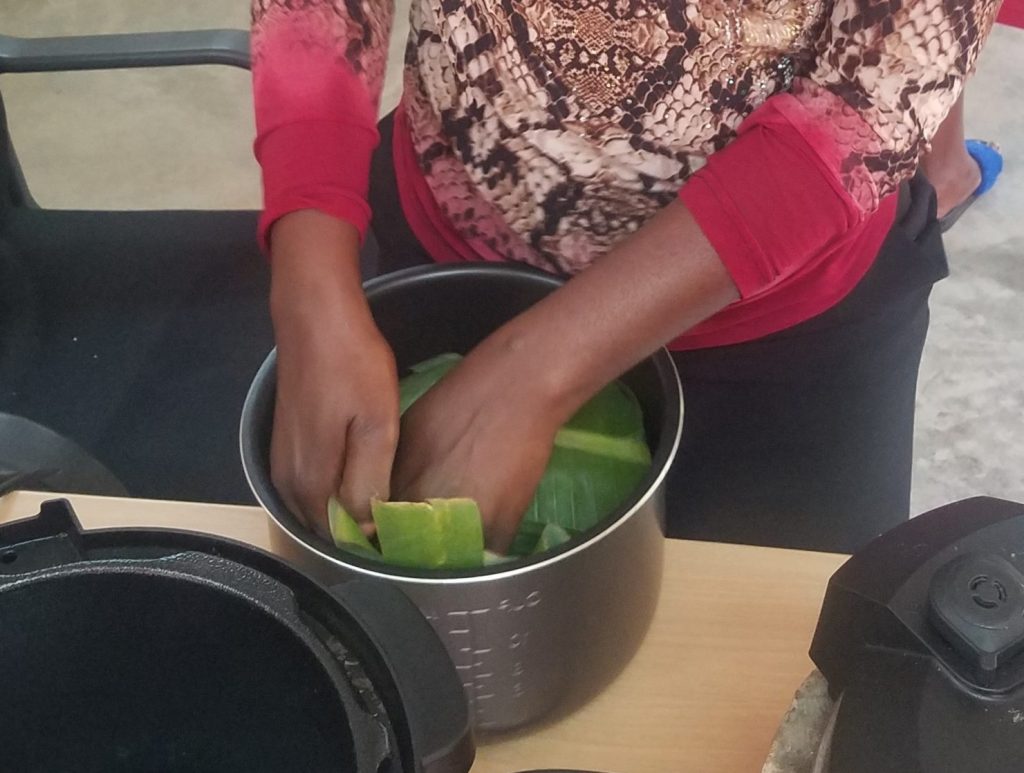
- Date
- 20th October 2020
- Categories
By Meron Tesfamichael (University College London), Agnes Naluwagga, Derrick Kiwana (CREEC).
In Kampala, preparing a dish of beans stew and matooke (a popular local dish) using charcoal takes four and a half hours. In contrast, an electric pressure cooker (EPC) takes two hours to deliver the same result and without compromising the quality in flavour and taste. This is what the research team at the Centre for Research Energy and Energy Conservation (CREEC) recently learned in their controlled cooking test. The study, which involved cooking locally cherished dishes using different cooking devices and fuels found that an EPC is consistently the least expensive and the most efficient option. This finding corresponds with similar studies in Kenya and Tanzania. In Uganda, the pressurising feature of an EPC proved particularly well suited for cooking staple meals such as matooke and beans, which require steaming and boiling. More importantly, these findings also suggest that in urban areas like Kampala, energy-efficient electrical cooking appliances offer a cleaner, efficient and affordable solution.

The electricity sector in Uganda has come so far in such a short time. From 2010 and 2019, the total installed electricity generation capacity doubled from 595 MW to 1200 MW. Years of investment in power generation capacity and a dynamic economy contributed to this achievement. The utility company is one of the few in Africa that is said to be fully recovering its operational costs from revenue collected. However, increasing generation capacity is an expensive undertaking (one study estimates 2.6 million USD per megawatt). Reports also show supply has outstripped demand or demand is declining as supply is increasing. Over-supply is not a desirable outcome for two reasons: first, power plants are built with borrowed money and public debt has to be paid off; second, the take-or-pay clause in power purchase agreements means generated power must be paid for, even if demand is not enough. Experts warn, this could lead to higher cost per kWh for users. If so, a higher tariff would be an unfortunate consequence because at 0.18 USD/kWh the cost of electricity in Uganda is already high. The value consumers derive from electricity access is limited due to the perceived high cost of electricity.

In Kampala, although almost all households have access to electricity, very few are using it for cooking. Nationwide unprocessed biomass and charcoal make up over 95 per cent of fuel use, while liquefied petroleum gas (LPG), kerosene and electricity make up the rest. In Kampala, demand for charcoal and charcoal production is likely to increase rapidly over the next few decades due to population grows and urbanisation. Thus, likely to exacerbate the problem of environmental degradation. The controlled cooking test carried out in Kampala and reported here indicates modern and efficient cooking energy technologies could elevate some of these challenges. In low- and middle-income countries like Uganda clean and cooking technologies offer enormous promise to advance at least five of the UN Sustainable Development Goals (SDGs): good health and well-being (Goal 3); gender equality (Goal 5); affordable and clean energy (Goal 7); climate action (Goal 13); and life and land (Goal 15).
To realise these enormous gains service providers and policy actors must work together to connect the dots between cooking and electricity. This may include a range of undertakings including raising awareness and strengthening the supply chain for modern and (cost and energy) efficient cooking technologies. A comprehensive demand stimulating approach should also include communities for whom high cost and accessibility act as a barrier. Uganda, like many of its neighbouring countries, maintains a lifeline electricity tariff for households that consume less than 15 kWh a month. However, compared to Ethiopia and Kenya, where lifeline tariff applies to households consuming less than 50 kWh, or Tanzania’s at 75 kWh and Zambia’s at 200 kWh, Uganda’s 15 kWh is quite low. In other words, when it comes to striking a balance between cost recovery and affordability, Uganda has done well on the former, but not-so-well on the latter. However, there are some promising starts: The National Energy Policy Bill (currently in draft stage) is outlines a plan to create an enabling framework to incentivise households switching from biomass to efficient and modern fuels and technologies including electric pressure cookers.